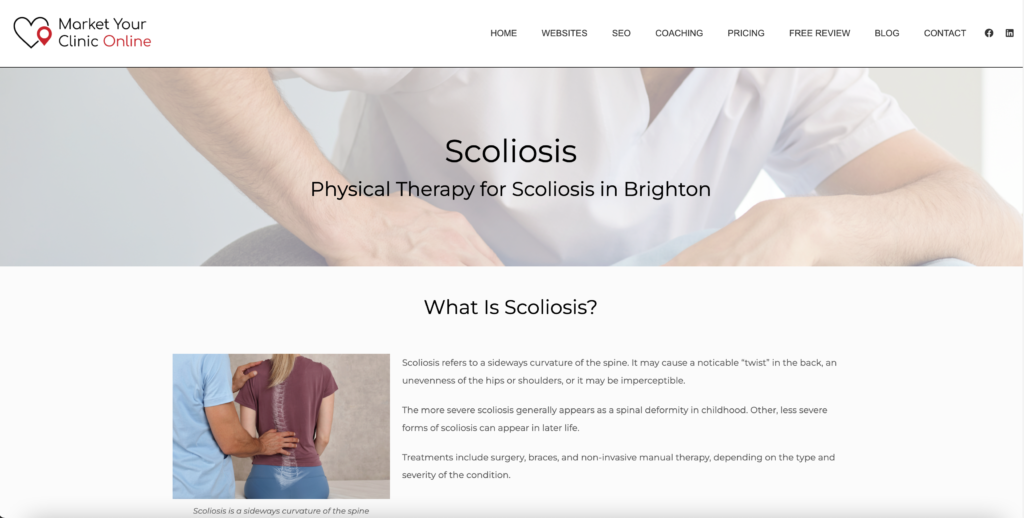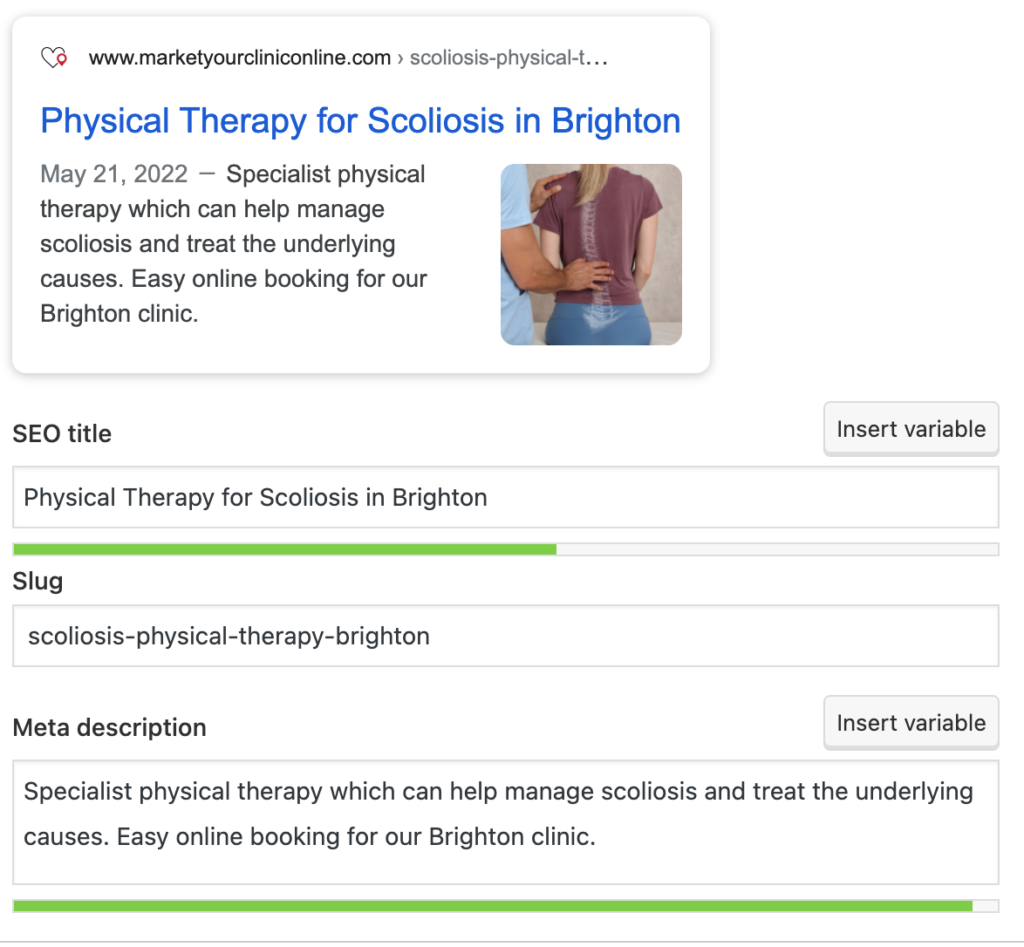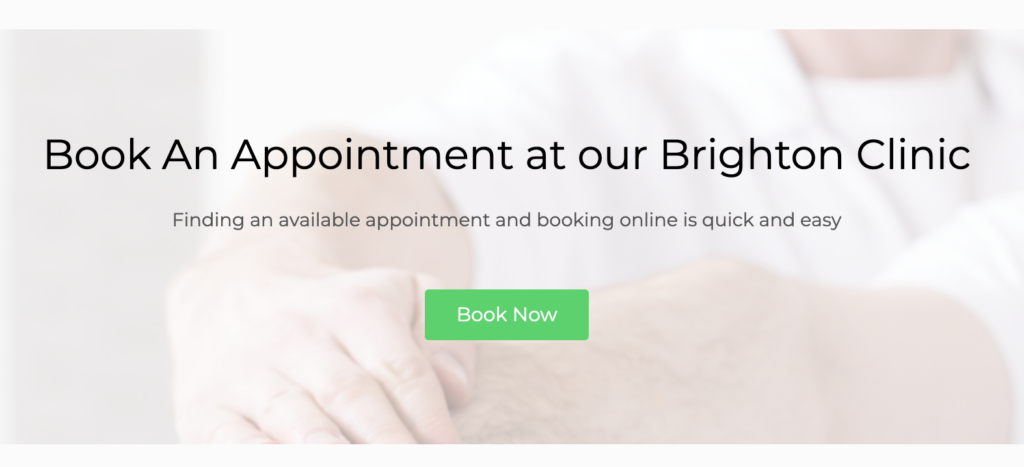Most clinics have some information about the conditions they treat on their website. Done well, this can be great for SEO, plus boost your credibility to potential patients.
We’ve created a scoliosis page for a fictional clinic at https://www.marketyourcliniconline.com/scoliosis-physical-therapy-brighton/, which we’ll reference as we look at how to create the perfect condition page.

Why Include Condition Pages?
Condition pages serve several purposes:
- They give us an opportunity to show up in searches for anyone searching treatment for that condition in our geographical location. For this reason we create the page with SEO for those search terms in mind.
- They are useful and reassuring to anyone coming to the website who wants treatment for that condition, regardless of whether they arrived at our site by searching for that specific condition.
- They raise our profile in the eyes of the potential patient by showing that (a) we know what we’re talking about, (b) we can explain our knowledge clearly, and (c) we care enough to create these condition pages in the first place
- They give us a general SEO boost because our website is a more comprehensive source of information
- They make it easier for us to get inbound links to our site because we have more useful information to offer
Heading 1, URL and Title Tags
The most important parts our page for SEO are the <h1> and <title> tags and the page URL (address). The most important words we want to optimise for are the condition, our location and the treatment we offer, in this case scoliosis, physical therapy and Brighton.
These words are all featured in these areas, as well as in the <meta> description for the page, telling search engines and users immediately what the page is about and what location it is relevant to:

Why Physical Therapy?
Our example is an osteopath but we’ve emphasised physical therapy rather than osteopathy. This is because, when searching for scoliosis treatment, people typically search for a doctor, specialist or physical therapy (see our Manual Therapy SEO Reference Guide).

We could have called the page Scoliosis Specialist but if the osteopath provides general treatment this could look fake, and we can still hit the term specialist by saying that we provide specialist treatment. What we can’t say is that we provide scoliosis treatment because this is against ASA guidelines for osteopathy. Instead we say that we provide specialist treatment that can help manage scoliosis, and similar phrases.
Page Structure and Content
There’s no sense reinventing the wheel and trying to provide the level of comprehensive information that a user could get from a website like Wikipedia. We have to find the right level of depth for our needs. As a clinic, what’s most useful to our visitors is a general overview of the condition and its treatment, information about what we can do and an appointment link, and links to find more in-depth information, support groups and so on if they want it.
Generally, a structure like the one below or something similar will be perfect for a clinic condition page:
- What is the condition
- What are the causes of the condition
- How is the condition treated
- What is our approach to treating the condition
- Information about our clinic and booking an appointment
- Useful links and resources
- Links to other pages and blog articles
- “Medical Review”
The debate rages about how long a page should be for SEO, but I find this generally works out to about 1000-2000 words.
Title Tag Structure
We want to feature our keywords liberally in our title tags so that Google knows what the page is about, but not in every single one. Our title structure is:
- Physical Therapy for Scoliosis in Brighton
- What is Scoliosis?
- Different types of Scoliosis
- Idiopathic Scoliosis
- Degenerative Scoliosis
- Functional Scoliosis
- How is Scoliosis treated?
- Surgery
- Braces
- Medicine
- Physical Therapy
- Our Approach to Scoliosis
- Book an Appointment at our Brighton Clinic
- From our Blog
- Useful links
These feature our keywords of scoliosis, Brighton and physical therapy without overdoing it. Note that we’ve phrased some of our subheadings as questions, which Google also likes.
Authoritative Outbound Links
To be useful to patients and to show Google that we’re “plugged in” to the wider conversation and to authority sources on the subject, we aim to include a minimum of 10-15 authority outbound links in our page. This way we become a hub of information, which raises our Google value. Our example page links to:
- Orthinfo.com page on scoliosis in adolescents
- Spine-health.com page on degenerative scoliosis
- NHS page on scoliosis in children
- Healthline.com page on scoliosis braces
- WebMD page on scoliosis exercises
- Physiopedia page on aquatherapy
- Healthline page on spinal manipulation
- NHS page on Allied Health
- General Osteopathic Council
- Institute of Osteopathy
- Firstcontactpractitioner.org.uk
- Scoliosis Association UK
- Scoliosis Research Society
- Kidshealth.org page on scoliosis in children
- Spinehealth information on scoliosis
- Orthinfo scoliosis page
- WebMD scoliosis page
- NHS scoliosis page
Good Internal Linking
We also need useful links within our own site, again both useful to users and increasing our Google value. Our example page links to the following pages on the fictional website. (note the links don’t actually work as the page is an example)
- Ankle injury page
- Sciatica page
- Clinic page
- About osteopathy page
- About us page
- What to expect page
- Contact us page
- Book appointment link
- 2 x blog posts
Including links to your own blog is really useful. A blog allows you to keep general information on your condition page whilst going into more detail on specific aspects of condition on the blog.
Medical Review
When you’re giving medical information Google likes to know that you’re qualified to do so, something called the E-A-T principle. By showing that the information has been reviewed by a qualified practitioner with a link to their page, we increase the value of the page both to Google and to the potential patient.
It’s a good idea to re-review every year or so and update the page and the date. It looks good to potential patients and Google prefers information which is periodically reviewed and updated.
Image Captions
Just like with our heading tags, we also want our image captions and alt tags to both include our keywords and to give an overview of what the page is about on their own. Our image captions are:
- Scoliosis is a sideways curvature of the spine
- There are three main types of scoliosis
- Physical therapy can help to manage scoliosis
- We are here to help with you or your child’s scoliosis
- There are various organisations who can help with scoliosis

Call to Action
Lastly but very importantly, we want to invite the user to make an appointment at our clinic. We might mention how easy it is to make an appointment, that we open evenings, have free parking or anything else that we can do to make our proposition attractive, but most importantly the user is invited to book an appointment straight away.

Conclusion
Condition pages are an important part of your clinic website and a powerful tool for SEO and conversion. Focus on creating high-quality, SEO-focused pages and building on them over time to create a knowledge base. This will then help you to convert visitors, be found online and garner inbound links to your site.
